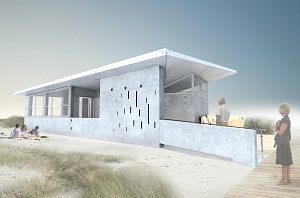Team New Jersey uses concrete for solar home
 – Ed note: This is the first of a regular series following Team New Jersey’s preparation for the 2011 Solar Decathlon
– Ed note: This is the first of a regular series following Team New Jersey’s preparation for the 2011 Solar Decathlon
Every two years since 2002, the United States Department of Energy hosts one of the most impressive solar competitions in the world—the Solar Decathlon.
Students from 20 different university teams submitted plans last month for the energy efficient solar-powered homes they will build on the mall in Washington, D.C., next October.
Team New Jersey, made up of students from Rutgers University, the State University of New Jersey and the New Jersey Institute of Technology, aims to win by using an affordable and simple building material never before used in the competition.
Pre-cast concrete will help the team’s 930-square-foot home designed for a retired couple living on the New Jersey shore to maintain a comfortable temperature during hot summers and cold winters without using a lot of energy, said Jen Switala, an architecture major at the New Jersey Institute of Technology.
“On a cold day, when the sun is shining on the concrete,” Switala said, “it absorbs the heat, and you can feel the warmth on the surface of it even at night.”
Concrete is a functional building material that eliminates a lot of construction supplies, labor, time, and expense, Switala said.
It can also be pleasant to look at if handled properly. Stained concrete floors have become popular in modern homes for a reason.
Concrete has become a more attractive building material in recent years, Switala said.
“It’s to the point where we can use concrete to build a home that someone can really live in,” she said.
The material will also make construction and transportation of the home easier and faster. Switala said Team New Jersey expects the home to take only one week to build. It will then be disassembled and transported in three sections to Washington, D.C., where the team believes it will be able to reconstruct the home in just 12 hours. The solar roof system will be shipped on a fourth truck, she said.
The home’s bathroom and kitchen will be concentrated in a wet cell with piping and electricity cast directly into the concrete walls, Switala said. Concentrating the plumbing needs of the home will also make it easier to assemble, disassemble and re-assemble.
This is the first year the Solar Decathlon competition has included affordability as a criteria. There were some complaints last year after Team Germany won with a home almost completely covered in photovoltaic solar panels.
Switala said affordability and sustainability were both major factors in the teams selection of concrete as the construction material.
• Check Clean Energy Authority next week for more on Team New Jersey’s solar home design
Pictured: One of the most recent renderings of Team New Jersey's solar house.



